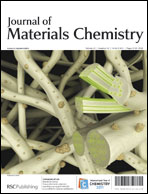Cobalt-intercalated layered manganese oxide (CLMO, K0.08Co0.12MnO2), in which 75% of the potassium ions of the pristine K-birnessite (K0.32MnO2) in the interlayer region were exchanged with cobalt ions by an ion-exchanging reaction, and the polyaniline-coated CLMO prepared by chemical oxidative polymerization of aniline in an acidic medium were studied using synchrotron powder X-ray diffraction (XRD), thermogravimetric analysis (TGA), Fourier transform infrared (FT-IR) spectroscopy, extended X-ray absorption fine structure (EXAFS), X-ray absorption near edge spectroscopy (XANES) and scanning electron microscopy (SEM). The electrochemical performance of CLMO and polyaniline-coated CLMO was investigated for application as cathode electrode material for lithium ion batteries. Due to the effective pillaring effect of exchanged cobalt ions in the interlayer region, CLMO showed excellent cyclability over 40 cycles, although it exhibited a low discharge capacity (143 mAh/g at 40 mA g−1 current density). Polyaniline-coated CLMO, in addition to its excellent cyclability, presented a much higher discharge capacity (253 mAh/g) than that of CLMO at a current density of 40 mA g−1 in the range 1.5–4.0 V. These results demonstrate that intercalated cobalt ions in the interlayer region can supply sufficient structural stability during charge-discharge cycles and, furthermore, subsequent polyaniline coating on the surface of a cathode electrode can bring out surface stabilization that prevents an unwanted reaction between the electrode and electrolytes.

You have access to this article
 Please wait while we load your content...
Something went wrong. Try again?
Please wait while we load your content...
Something went wrong. Try again?


 Please wait while we load your content...
Please wait while we load your content...